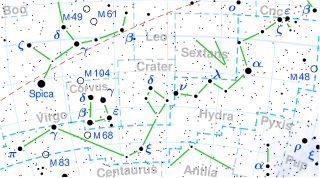| Observation data Epoch J2000 Equinox J2000 | |
|---|---|
| Constellation | Hydra |
| Right ascension | 10h 10m 35.27667s[1] |
| Declination | −12° 21′ 14.6938″[1] |
| Apparent magnitude (V) | 3.61[2] |
| Characteristics | |
| Spectral type | K0IIIbCN0.5[3] |
| U−B color index | 0.92[4] |
| B−V color index | 1.00[4] |
| Astrometry | |
| Radial velocity (Rv) | 19.4[5] km/s |
| Proper motion (μ) | RA: -201.27[1] mas/yr Dec.: -99.63[1] mas/yr |
| Parallax (π) | 30.0232 ± 0.6973 mas[6] |
| Distance | 109 ± 3 ly (33.3 ± 0.8 pc) |
| Absolute magnitude (MV) | +0.92[7] |
| Orbit[8] | |
| Period (P) | 1585.8 days |
| Semi-major axis (a) | 16.79 mas |
| Eccentricity (e) | 0.138 |
| Inclination (i) | 79.49° |
| Longitude of the node (Ω) | 249.62° |
| Periastron epoch (T) | 2448664.3906 |
| Argument of periastron (ω) (secondary) | 238.9° |
| Details | |
| λ Hya A | |
| Mass | 1-2[9] M☉ |
| Radius | 9.7[9] R☉ |
| Luminosity | 39.8[9] L☉ |
| Surface gravity (log g) | 2.64[9] cgs |
| Temperature | 4,656[9] K |
| Metallicity [Fe/H] | +0.25[10] dex |
| Rotational velocity (v sin i) | 1.9[11] km/s |
| Other designations | |
| Database references | |
| SIMBAD | data |
λ Hydrae, Latinised as Lambda Hydrae, is a spectroscopic binary[12] star in the constellation Hydra. Its apparent magnitude is 3.61 Located around 33.3 parsecs (109 ly) distant. The spiral galaxy NGC 3145 is only 7.8′ away to the southwest.
The primary is an orange giant of spectral type K0IIICN+1,[13] a star that has used up its core hydrogen, left the main sequence, and expanded into a giant. It is considered to be a red clump giant, a cool horizontal branch star that is burning helium in its core.[14]
λ Hydrae has two visual companions, components B and C, 11th and 13th magnitude stars respectively 71″ and 111″ away.[15]
References
- ^ a b c d van Leeuwen, F. (November 2007). "Validation of the new Hipparcos reduction". Astronomy and Astrophysics. 474 (2): 653–664. arXiv:0708.1752. Bibcode:2007A&A...474..653V. doi:10.1051/0004-6361:20078357. S2CID 18759600.
- ^ Ducati, J. R. (2002). "VizieR Online Data Catalog: Catalogue of Stellar Photometry in Johnson's 11-color system". CDS/ADC Collection of Electronic Catalogues. 2237: 0. Bibcode:2002yCat.2237....0D.
- ^ Keenan, Philip C.; McNeil, Raymond C. (1989). "The Perkins Catalog of Revised MK Types for the Cooler Stars". The Astrophysical Journal Supplement Series. 71: 245. Bibcode:1989ApJS...71..245K. doi:10.1086/191373.
- ^ a b Jennens, P. A. (1975). "A new photometric metal abundance and luminosity calibration for field G and K giants". Monthly Notices of the Royal Astronomical Society. 172 (3): 667–679. Bibcode:1975MNRAS.172..667J. doi:10.1093/mnras/172.3.667.
- ^ Wilson, Ralph Elmer (1953). "General catalogue of stellar radial velocities". Carnegie Institute Washington D.C. Publication: 0. Bibcode:1953GCRV..C......0W.
- ^ Brown, A. G. A.; et al. (Gaia collaboration) (August 2018). "Gaia Data Release 2: Summary of the contents and survey properties". Astronomy & Astrophysics. 616. A1. arXiv:1804.09365. Bibcode:2018A&A...616A...1G. doi:10.1051/0004-6361/201833051. Gaia DR2 record for this source at VizieR.
- ^ Anderson, E.; Francis, Ch. (2012), "XHIP: An extended hipparcos compilation", Astronomy Letters, 38 (5): 331, arXiv:1108.4971, Bibcode:2012AstL...38..331A, doi:10.1134/S1063773712050015, S2CID 119257644.
- ^ ESA (1997). "The Hipparcos and Tycho Catalogues". VizieR On-line Data Catalog. Bibcode:1997yCat.1239....0E.
- ^ a b c d e Cruzalèbes, P.; Rabbia, Y.; Jorissen, A.; Spang, A.; Sacuto, S.; Pasquato, E.; Chiavassa, A.; Chesneau, O.; Fréville, P. (2013). "SPIDAST: A new modular software to process spectrointerferometric measurements". Monthly Notices of the Royal Astronomical Society. 432 (2): 1658. arXiv:1304.1666. Bibcode:2013MNRAS.432.1658C. doi:10.1093/mnras/stt593.
- ^ Hinkel, Natalie R.; Timmes, F. X.; Young, Patrick A.; Pagano, Michael D.; Turnbull, Margaret C. (2014). "Stellar Abundances in the Solar Neighborhood: The Hypatia Catalog". The Astronomical Journal. 148 (3): 54. arXiv:1405.6719. Bibcode:2014AJ....148...54H. doi:10.1088/0004-6256/148/3/54. S2CID 119221402.
- ^ De Medeiros, J. R.; Da Silva, J. R. P.; Maia, M. R. G. (2002). "The Rotation of Binary Systems with Evolved Components". The Astrophysical Journal. 578 (2): 943–950. arXiv:astro-ph/0207288. Bibcode:2002ApJ...578..943D. doi:10.1086/342613.
- ^ Eggleton, P. P.; Tokovinin, A. A. (September 2008). "A catalogue of multiplicity among bright stellar systems". Monthly Notices of the Royal Astronomical Society. 389 (2): 869–879. arXiv:0806.2878. Bibcode:2008MNRAS.389..869E. doi:10.1111/j.1365-2966.2008.13596.x. S2CID 14878976.
- ^ Gray, R. O.; et al. (July 2006). "Contributions to the Nearby Stars (NStars) Project: spectroscopy of stars earlier than M0 within 40 pc-The Southern Sample". The Astronomical Journal. 132 (1): 161–170. arXiv:astro-ph/0603770. Bibcode:2006AJ....132..161G. doi:10.1086/504637. S2CID 119476992.
- ^ Alves, David R. (2000). "K-Band Calibration of the Red Clump Luminosity". The Astrophysical Journal. 539 (2): 732–741. arXiv:astro-ph/0003329. Bibcode:2000ApJ...539..732A. doi:10.1086/309278.
- ^ Mason, Brian D.; Wycoff, Gary L.; Hartkopf, William I.; Douglass, Geoffrey G.; Worley, Charles E. (2001). "The 2001 US Naval Observatory Double Star CD-ROM. I. The Washington Double Star Catalog". The Astronomical Journal. 122 (6): 3466. Bibcode:2001AJ....122.3466M. doi:10.1086/323920.

